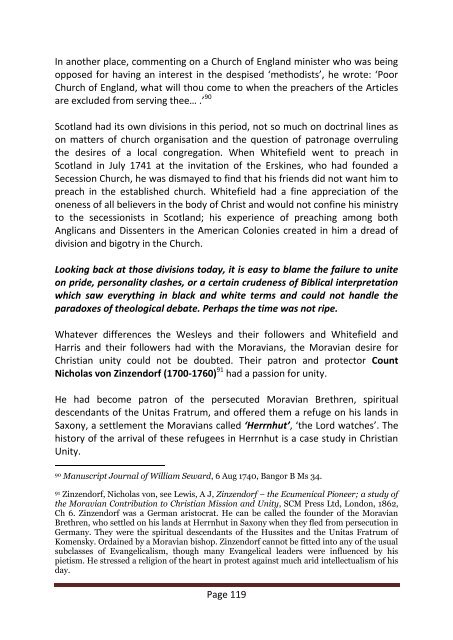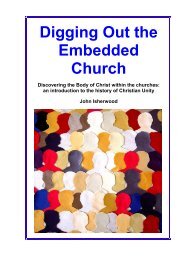Christian Unity (the book) - The Maranatha Community
Christian Unity (the book) - The Maranatha Community
Christian Unity (the book) - The Maranatha Community
Create successful ePaper yourself
Turn your PDF publications into a flip-book with our unique Google optimized e-Paper software.
In ano<strong>the</strong>r place, commenting on a Church of England minister who was beingopposed for having an interest in <strong>the</strong> despised ‘methodists’, he wrote: ‘PoorChurch of England, what will thou come to when <strong>the</strong> preachers of <strong>the</strong> Articlesare excluded from serving <strong>the</strong>e… .’ 90Scotland had its own divisions in this period, not so much on doctrinal lines ason matters of church organisation and <strong>the</strong> question of patronage overruling<strong>the</strong> desires of a local congregation. When Whitefield went to preach inScotland in July 1741 at <strong>the</strong> invitation of <strong>the</strong> Erskines, who had founded aSecession Church, he was dismayed to find that his friends did not want him topreach in <strong>the</strong> established church. Whitefield had a fine appreciation of <strong>the</strong>oneness of all believers in <strong>the</strong> body of Christ and would not confine his ministryto <strong>the</strong> secessionists in Scotland; his experience of preaching among bothAnglicans and Dissenters in <strong>the</strong> American Colonies created in him a dread ofdivision and bigotry in <strong>the</strong> Church.Looking back at those divisions today, it is easy to blame <strong>the</strong> failure to uniteon pride, personality clashes, or a certain crudeness of Biblical interpretationwhich saw everything in black and white terms and could not handle <strong>the</strong>paradoxes of <strong>the</strong>ological debate. Perhaps <strong>the</strong> time was not ripe.Whatever differences <strong>the</strong> Wesleys and <strong>the</strong>ir followers and Whitefield andHarris and <strong>the</strong>ir followers had with <strong>the</strong> Moravians, <strong>the</strong> Moravian desire for<strong>Christian</strong> unity could not be doubted. <strong>The</strong>ir patron and protector CountNicholas von Zinzendorf (1700-1760) 91 had a passion for unity.He had become patron of <strong>the</strong> persecuted Moravian Brethren, spiritualdescendants of <strong>the</strong> Unitas Fratrum, and offered <strong>the</strong>m a refuge on his lands inSaxony, a settlement <strong>the</strong> Moravians called ‘Herrnhut’, ‘<strong>the</strong> Lord watches’. <strong>The</strong>history of <strong>the</strong> arrival of <strong>the</strong>se refugees in Herrnhut is a case study in <strong>Christian</strong><strong>Unity</strong>.90Manuscript Journal of William Seward, 6 Aug 1740, Bangor B Ms 34.91Zinzendorf, Nicholas von, see Lewis, A J, Zinzendorf – <strong>the</strong> Ecumenical Pioneer; a study of<strong>the</strong> Moravian Contribution to <strong>Christian</strong> Mission and <strong>Unity</strong>, SCM Press Ltd, London, 1862,Ch 6. Zinzendorf was a German aristocrat. He can be called <strong>the</strong> founder of <strong>the</strong> MoravianBrethren, who settled on his lands at Herrnhut in Saxony when <strong>the</strong>y fled from persecution inGermany. <strong>The</strong>y were <strong>the</strong> spiritual descendants of <strong>the</strong> Hussites and <strong>the</strong> Unitas Fratrum ofKomensky. Ordained by a Moravian bishop. Zinzendorf cannot be fitted into any of <strong>the</strong> usualsubclasses of Evangelicalism, though many Evangelical leaders were influenced by hispietism. He stressed a religion of <strong>the</strong> heart in protest against much arid intellectualism of hisday.Page 119








